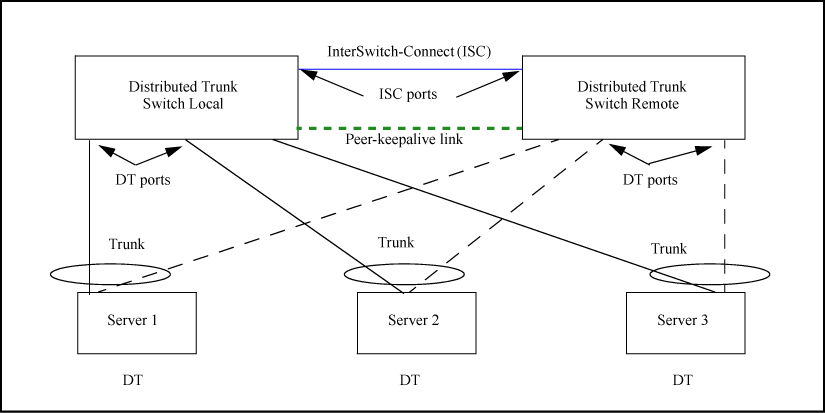The IEEE standard 802.3ad requires that all links in a trunk group originate from the same switch. Distributed trunking uses a proprietary protocol that allows two or more port trunk links distributed across two switches to create a trunk group. The grouped links appear to the downstream device as if they are from a single device. This allows third party devices such as switches, servers, or any other networking device that supports trunking to interoperate with the distributed trunking switches (DTSs) seamlessly. Distributed trunking provides device-level redundancy in addition to link failure protection.
DTSs are connected by a special interface called the InterSwitch-Connect (ISC) port. This interface exchanges information so that the DTSs appear as a single switch to a downstream device, as mentioned above. Each distributed trunk (DT) switch in a DT pair must be configured with a separate ISC link and peer-keepalive link. The peer-keepalive link is used to transmit keepalive messages when the ISC link is down to determine if the failure is a link-level failure or the complete failure of the remote peer.
The downstream device is a distributed trunking device (DTD.) The DTD forms a trunk with the DTSs. The connecting links are DT links and the ports are DT ports. A distributed trunk can span a maximum of two switches.
|
|
|
![[NOTE: ]](images/note.gif) |
NOTE: DT between different type of switches is not supported. |
|
|
You can group together distributed trunks by configuring two individual dt-lacp/dt-trunk trunks with the same trunk group name in each switch. The DT ports are grouped dynamically after the configuration of distributed trunking.
|
|
|
![[NOTE: ]](images/note.gif) |
NOTE: Before you configure the switch, HP recommends that you review the Distributed trunking restrictions for a complete list of operating notes and restrictions. |
|
|
In Example of distributed trunking with three different distributed trunks with three servers, three different distributed trunks with three different servers have one common ISC link. Each trunk spans only two DTSs, which are connected at the ISC ports so they can exchange information that allows them to appear as one device to the server.
An example of distributed trunking switch-to-switch in a square topology is shown in Distributed trunking switch-to-switch square topology.
Distributed trunking uses the distributed trunking interconnect protocol (DTIP) to transfer DT-specific configuration information for the comparison process and to synchronize MAC and DHCP snooping binding data between the two DT peer switches.
|
|
|
![[NOTE: ]](images/note.gif) |
NOTE: For DHCP snooping to function correctly in a DT topology, the system time must be the same on both switches, and the ISC must be trusted for DHCP snooping. |
|
|
The following parameters must be configured identically on the peer devices or undesirable behavior in traffic flow may occur:
-
The ISC link must have a VLAN interface configured for the same VLAN on both DT switches.
-
VLAN membership for all DT trunk ports should be the same on both DT switches in a DT pair.
-
IGMP-snooping or DHCP-snooping configuration on a DT VLAN should be the same on both DT switches. For example, for a DT, if IGMP-snooping or DHCP-snooping is enabled on a VLAN that has a DT port as a member port of the VLAN, the same must be configured on the peer DT on the same VLAN.
-
Loop-protection configuration on a DT VLAN should be the same for both DT switches.

